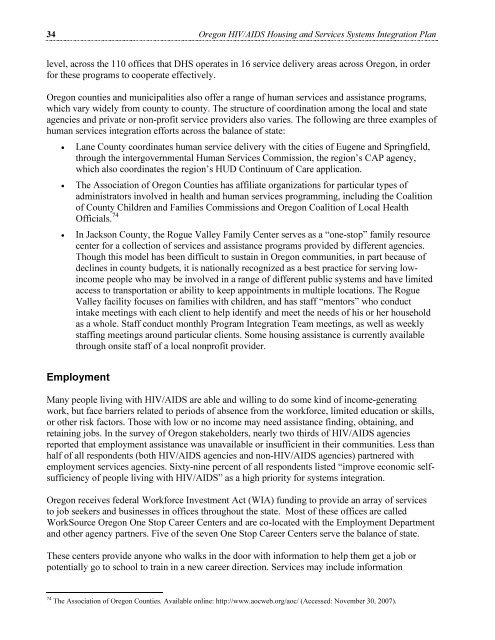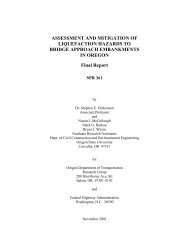Oregon Balance of State HIV/AIDS Housing & Services Systems ...
Oregon Balance of State HIV/AIDS Housing & Services Systems ...
Oregon Balance of State HIV/AIDS Housing & Services Systems ...
You also want an ePaper? Increase the reach of your titles
YUMPU automatically turns print PDFs into web optimized ePapers that Google loves.
34 <strong>Oregon</strong> <strong>HIV</strong>/<strong>AIDS</strong> <strong>Housing</strong> and <strong>Services</strong> <strong>Systems</strong> Integration Plan<br />
level, across the 110 <strong>of</strong>fices that DHS operates in 16 service delivery areas across <strong>Oregon</strong>, in order<br />
for these programs to cooperate effectively.<br />
<strong>Oregon</strong> counties and municipalities also <strong>of</strong>fer a range <strong>of</strong> human services and assistance programs,<br />
which vary widely from county to county. The structure <strong>of</strong> coordination among the local and state<br />
agencies and private or non-pr<strong>of</strong>it service providers also varies. The following are three examples <strong>of</strong><br />
human services integration efforts across the balance <strong>of</strong> state:<br />
• Lane County coordinates human service delivery with the cities <strong>of</strong> Eugene and Springfield,<br />
through the intergovernmental Human <strong>Services</strong> Commission, the region’s CAP agency,<br />
which also coordinates the region’s HUD Continuum <strong>of</strong> Care application.<br />
• The Association <strong>of</strong> <strong>Oregon</strong> Counties has affiliate organizations for particular types <strong>of</strong><br />
administrators involved in health and human services programming, including the Coalition<br />
<strong>of</strong> County Children and Families Commissions and <strong>Oregon</strong> Coalition <strong>of</strong> Local Health<br />
Officials. 74<br />
• In Jackson County, the Rogue Valley Family Center serves as a “one-stop” family resource<br />
center for a collection <strong>of</strong> services and assistance programs provided by different agencies.<br />
Though this model has been difficult to sustain in <strong>Oregon</strong> communities, in part because <strong>of</strong><br />
declines in county budgets, it is nationally recognized as a best practice for serving lowincome<br />
people who may be involved in a range <strong>of</strong> different public systems and have limited<br />
access to transportation or ability to keep appointments in multiple locations. The Rogue<br />
Valley facility focuses on families with children, and has staff “mentors” who conduct<br />
intake meetings with each client to help identify and meet the needs <strong>of</strong> his or her household<br />
as a whole. Staff conduct monthly Program Integration Team meetings, as well as weekly<br />
staffing meetings around particular clients. Some housing assistance is currently available<br />
through onsite staff <strong>of</strong> a local nonpr<strong>of</strong>it provider.<br />
Employment<br />
Many people living with <strong>HIV</strong>/<strong>AIDS</strong> are able and willing to do some kind <strong>of</strong> income-generating<br />
work, but face barriers related to periods <strong>of</strong> absence from the workforce, limited education or skills,<br />
or other risk factors. Those with low or no income may need assistance finding, obtaining, and<br />
retaining jobs. In the survey <strong>of</strong> <strong>Oregon</strong> stakeholders, nearly two thirds <strong>of</strong> <strong>HIV</strong>/<strong>AIDS</strong> agencies<br />
reported that employment assistance was unavailable or insufficient in their communities. Less than<br />
half <strong>of</strong> all respondents (both <strong>HIV</strong>/<strong>AIDS</strong> agencies and non-<strong>HIV</strong>/<strong>AIDS</strong> agencies) partnered with<br />
employment services agencies. Sixty-nine percent <strong>of</strong> all respondents listed “improve economic selfsufficiency<br />
<strong>of</strong> people living with <strong>HIV</strong>/<strong>AIDS</strong>” as a high priority for systems integration.<br />
<strong>Oregon</strong> receives federal Workforce Investment Act (WIA) funding to provide an array <strong>of</strong> services<br />
to job seekers and businesses in <strong>of</strong>fices throughout the state. Most <strong>of</strong> these <strong>of</strong>fices are called<br />
WorkSource <strong>Oregon</strong> One Stop Career Centers and are co-located with the Employment Department<br />
and other agency partners. Five <strong>of</strong> the seven One Stop Career Centers serve the balance <strong>of</strong> state.<br />
These centers provide anyone who walks in the door with information to help them get a job or<br />
potentially go to school to train in a new career direction. <strong>Services</strong> may include information<br />
74 The Association <strong>of</strong> <strong>Oregon</strong> Counties. Available online: http://www.aocweb.org/aoc/ (Accessed: November 30, 2007).

















